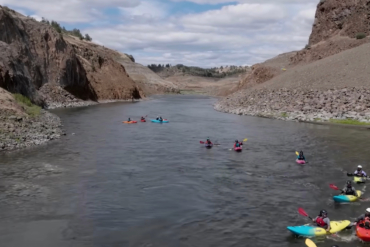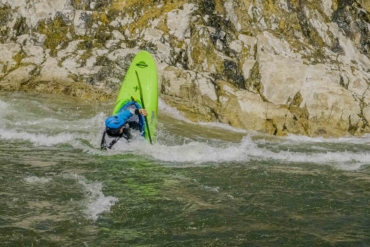Surfboard shapers have cut boards from foam blanks for over half a century. Now, many in the industry are seeking methods for building boards that reduce environmental pollution.
A recent trend in 3D-printed surfboards has opened the door for new ideas. Wyve, a French company based in a Basque beach community, looks to have set the new benchmark for sustainable surfboard designs.
Wyve’s range of boards uses an internal hexagonal structure that traps air inside instead of using a traditional foam blank. Unlike with other 3D-printed boards, the process bypasses polystyrene or EPS foam entirely.
Instead, it prints its hexagonal cores from PLA, a bio-based recyclable plastic made from fermented corn starch. Not only that, it commits to a locally based manufacturing and distribution model.
The method speaks to the company’s strongly stated position on environmental ethics in surfing. According to early internal testing and research, the construction also strengthens its boards’ performance in some key areas. And despite what the 3D-printing process might imply, custom-shaped boards come at no extra cost to the customer.
“We are trying to rethink the way we manufacture surfboards,” Léo Kerhir, head of sales and international development at Wyve, said. “We want to make them more high-performance and more sustainable. Using bio-based materials and the technology we’ve developed internally, we’re able to do that.”

Wyve 3D-Printed Surfboards Sustainability: A Brief Audit
“By buying traditional surfboards, the surfing community inadvertently supports a process which uses petrochemical materials and generates toxic waste,” Wyve states. “Whether in the local small shaper’s warehouse or in the famous Californian factories, for the last 60 years polyurethane and polyester have been polluting our air and oceans.”
To limit its emissions profile, the company pledges to gather materials and manufacture boards on a local basis. It calls the facilities that anchor the method “micro-factories.”
Kerhir said the company’s growth model revolves around establishing micro-factories and distribution networks along each coast it plans to expand to. For now, the company delivers boards to Europe exclusively.
Locally sourced materials will remain a priority. One PLA manufacturer, Total Corbion PLA, has factories in the Netherlands and Spain, and a sales office in France. And while Wyve does epoxy-coat its fiberglass boards for durability, it uses a bio-based epoxy resin manufactured in France.
View this post on Instagram
Performance goes hand in hand with Wyve’s sustainability positions. The overall conclusion is simple: “Surfers deserve better.”
Wyve Performance Testing and Reported Research
Sustainability aside, the majority of surfers probably won’t find Wyve boards “better” unless they ride comparably to traditional boards. So far, Kehrir reports, the outlook is positive.
Local talents in the company’s home region of Anglet, France, are handling performance tests. Read Wyve’s report on earlier testing by its internal team at Switzerland’s Alaïa Bay wave pool here.
Buoyancy and repairability look to be the board’s key strong points. Testing has shown that the air-filled boards can float even better than their foam-core counterparts, and perform similarly for wave entry.
View this post on Instagram
They also look to have a clear advantage as far as ease of repair. If you ding a traditional board and puncture the shell, it will eventually soak and yellow unless you heat-dry it and patch it.
But Wyve’s boards have an air valve that both regulates pressure inside the board and allows for drainage in case of a puncture. When you do get a ding, all you have to do is drain it (the internal walls have openings to let water through) and patch it.
Kerhir confirmed that weight is similar to polyurethane boards. He also said the hexagonal structure is three times more resistant than a foam blank but retains the necessary flexibility. In fact, he told Magicseaweed, the 3D-printed cores help the company’s shapers control parameters like flex, mass repartition, and strength in key areas.
View this post on Instagram
Custom 3D-Printed Surfboards for Singular Surfers; Wyve Sees the Future
Finally, the plastic cores can also increase the capacity for personalized shaping. Wyve delivers 18 stock board shapes in 10 sizes each, suited to various styles. But it also offers a questionnaire-based order program to draw down on specific needs. After a conversation with the surfer in question, Wyve uses a logarithm to help inform its design process.
Consultation and custom shaping come at no extra cost.
“The stock shapes and sizes cover many people. But many surfers want to have their surfboard, with specific changes compared to the stock board,” Kerhir asserted. “So we offer customization at the same price, which we’re able to do thanks to the technology.”
Asked if he thought 3D-printed boards would become the new standard, Kerhir expressed optimism that Wyve’s method will find traction among intermediate- to high-level surfers. He said that because the company’s system allows for both precision and scaled production in custom boards, Wyve is “convinced 3D printing is the future” for surfers focused on performance.
View this post on Instagram
Check out Wyve’s website to learn more about its process and check out its array of 3D-printed, biodegradable surfboards. If you want to pick one up in Europe and ride it this summer, act now; Wyve is trying to drive lead time down, but current demand puts delivery dates 90 days out from the order date.








